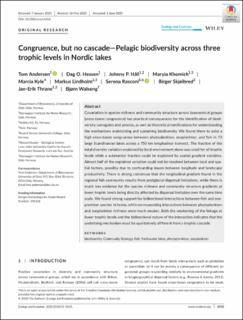| dc.contributor.author | Andersen, Tom | |
| dc.contributor.author | Hessen, Dag Olav | |
| dc.contributor.author | Håll, Johnny Peter | |
| dc.contributor.author | Khomich, Maryia | |
| dc.contributor.author | Kyle, Marcia | |
| dc.contributor.author | Lindholm, Markus | |
| dc.contributor.author | Rasconi, Serena | |
| dc.contributor.author | Skjelbred, Birger | |
| dc.contributor.author | Thrane, Jan-Erik | |
| dc.contributor.author | Walseng, Bjørn | |
| dc.date.accessioned | 2020-08-17T12:40:20Z | |
| dc.date.available | 2020-08-17T12:40:20Z | |
| dc.date.created | 2020-08-06T13:31:06Z | |
| dc.date.issued | 2020 | |
| dc.identifier.citation | Ecology and Evolution. 2020, 10 (15), 8153-8165. | en_US |
| dc.identifier.issn | 2045-7758 | |
| dc.identifier.uri | https://hdl.handle.net/11250/2672636 | |
| dc.description.abstract | Covariation in species richness and community structure across taxonomical groups (cross‐taxon congruence) has practical consequences for the identification of biodiversity surrogates and proxies, as well as theoretical ramifications for understanding the mechanisms maintaining and sustaining biodiversity. We found there to exist a high cross‐taxon congruence between phytoplankton, zooplankton, and fish in 73 large Scandinavian lakes across a 750 km longitudinal transect. The fraction of the total diversity variation explained by local environment alone was small for all trophic levels while a substantial fraction could be explained by spatial gradient variables. Almost half of the explained variation could not be resolved between local and spatial factors, possibly due to confounding issues between longitude and landscape productivity. There is strong consensus that the longitudinal gradient found in the regional fish community results from postglacial dispersal limitations, while there is much less evidence for the species richness and community structure gradients at lower trophic levels being directly affected by dispersal limitation over the same time scale. We found strong support for bidirectional interactions between fish and zooplankton species richness, while corresponding interactions between phytoplankton and zooplankton richness were much weaker. Both the weakening of the linkage at lower trophic levels and the bidirectional nature of the interaction indicates that the underlying mechanism must be qualitatively different from a trophic cascade. | en_US |
| dc.language.iso | eng | en_US |
| dc.rights | Navngivelse 4.0 Internasjonal | * |
| dc.rights.uri | http://creativecommons.org/licenses/by/4.0/deed.no | * |
| dc.title | Congruence, but no cascade - Pelagic biodiversity across three trophic levels in Nordic lakes | en_US |
| dc.type | Peer reviewed | en_US |
| dc.type | Journal article | en_US |
| dc.description.version | publishedVersion | en_US |
| dc.source.pagenumber | 8153-8165 | en_US |
| dc.source.volume | 10 | en_US |
| dc.source.journal | Ecology and Evolution | en_US |
| dc.source.issue | 15 | en_US |
| dc.identifier.doi | 10.1002/ece3.6514 | |
| dc.identifier.cristin | 1822027 | |
| dc.relation.project | Norges forskningsråd: 196336 | en_US |
| cristin.ispublished | true | |
| cristin.fulltext | original | |
| cristin.qualitycode | 1 | |

